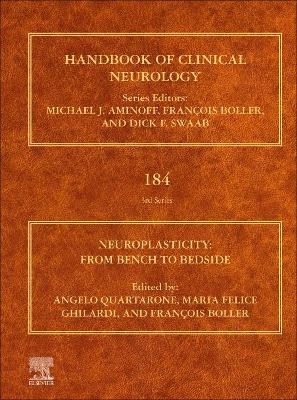
Neuroplasticity
Elsevier Science Publishing Co Inc (Verlag)
978-0-12-819410-2 (ISBN)
Angelo Quartarone is at the Department of Biomedical Sciences and Morphological and Functional Images, University of Messina, Messina, Italy. Dr. Maria Felice Ghilardi, a Medical Doctor specialized in Neurology graduated from the Universita' degli Studi di Milano, is currently Professor of Neuroscience at the CUNY School of Medicine in New York. Her research interests are: plasticity, motor control and learning, with a major focus on Parkinson's disease and neurodegenerative disorders. François Boller, M.D., Ph.D. has been co-Series Editor of the Handbook of Clinical Neurology since 2002. He.is a board-certified neurologist currently Professor of Neurology at the George Washington University Medical School (GW) in Washington, DC. He was born in Switzerland and educated in Italy where he obtained a Medical Degree at the University of Pisa. After specializing in Neurology at the University of Milan, Dr. Boller spent several years at the Boston VA and Boston University Medical School, including a fellowship under the direction of Dr. Norman Geschwind. He obtained a Ph.D. in Experimental Psychology from Case Western Reserve University in Cleveland, Ohio where he was in charge of Neuroscience teaching at the Medical School and was nominated Teacher of the Year. In 1983, Dr. Boller became Professor of Neurology and Psychiatry at the University of Pittsburgh where he founded and directed one of the first NIH funded Alzheimer Disease Research Centers in the country. In 1989, he was put in charge of a Paris-based INSERM Unit dedicated to the neuropsychology and neurobiology of cerebral aging. He returned to the United States and joined the NIH in 2005, before coming to GW in July 2014. Dr. Boller’s initial area of interest was aphasia and related disorders; he later became primarily interested in cognitive disorders and dementia with emphasis on the correlates of cognitive disorders with pathology, neurophysiology and imaging. He was one of the first to study the relation between Parkinson and Alzheimer disease, two processes that were thought to be unrelated. His current area of interest is Alzheimer’s disease and related disorders with emphasis on the early and late stages of the disease. He is also interested in the history of Neurosciences and is Past President of the International Society for the History of Neurosciences. He was the founding Editor-in-Chief of the European Journal of Neurology, the official Journal of the European Federation of Neurological Societies (now European Academy of Neurology). He is a Fellow of the American Academy of Neurology and a member of the American Neurological Association. In addition, he has chaired Committees within the International Neuropsychological Society, the International Neuropsychology Symposium, and the World Federation of Neurology (WFN). He has authored over 200 papers and books including the Handbook of Neuropsychology (Elsevier).
Section I. Introduction
1. Defining neuroplasticity
Section II. Neuroplasticity: Basic Mechanism and Assessment at System Level
2. Basic mechanisms of plasticity and learning
3. Local sleep: a new concept in brain plasticity
4. Sleep and homeostatic control of plasticity
5. Transcranial magnetic stimulation as a tool to induce and explore plasticity in humans
6. EEG as marker of brain plasticity in clinical applications
7. Tools to explore neuroplasticity in humans: Combining interventional neurophysiology with functional and structural magnetic resonance imaging and spectroscopy
8. Metabolic imaging and plasticity
Section III. Neuroplasticity in Movement Disorders
9. Parkinson’s disease: Alterations of motor plasticity and motor learning
10. Alpha-synuclein and cortico-striatal plasticity in animal models of Parkinson disease
11. Plasticity, genetics, and epigenetics in L-DOPA-induced dyskinesias
12. Non-invasive neuromodulation in Parkinson's disease: Neuroplasticity implication and therapeutic perspectives
13. Plasticity, genetics and epigenetics in dystonia: An update
14. Neuroplasticity in dystonia: Motor symptoms and beyond
Section IV. Brain Oscillations in Neurological Disorders
15. General principles of brain electromagnetic rhythmic oscillations and implications for neuroplasticity
16. Noninvasive brain stimulation and brain oscillations
17. Brain oscillatory dysfunctions in dystonia
18. Brain oscillations and Parkinson disease
19. Adaptive deep brain stimulation: Retuning Parkinson's disease
Section V. Plasticity and Rehabilitation
20. Biomarkers of plasticity for stroke recovery
21. New tools for shaping plasticity to enhance recovery after stroke
22. Neuroplasticity of spinal cord injury and repair
23. Reward and plasticity: Implications for neurorehabilitation
24. Rehabilitation in movement disorders: From basic mechanisms to clinical strategies
25. Rehabilitation of visual perception in cortical blindness
26. The role of plasticity in the recovery of consciousness
27. Plasticity of the language system in children and adults
Section VI. Inflammation, Autoimmunity, and Plasticity
28. Synaptic dysfunction in early phases of Alzheimer's disease
29. T-cells, alpha-synuclein, and Parkinson disease
30. Multiple Sclerosis: Inflammation, autoimmunity and plasticity
Section VII. Plasticity in Cognitive and Psychiatric Disorders
31. Alzheimer disease and neuroplasticity
32. From chronic stress and anxiety to neurodegeneration: Focus on neuromodulation of the axon initial segment
33. Shaping plasticity with non-invasive brain stimulation in the treatment of psychiatric disorders: Present and future
| Erscheinungsdatum | 09.05.2022 |
|---|---|
| Reihe/Serie | Handbook of Clinical Neurology |
| Sprache | englisch |
| Maße | 195 x 260 mm |
| Gewicht | 1660 g |
| Themenwelt | Medizin / Pharmazie ► Medizinische Fachgebiete ► Neurologie |
| Naturwissenschaften ► Biologie ► Humanbiologie | |
| Naturwissenschaften ► Biologie ► Zoologie | |
| ISBN-10 | 0-12-819410-3 / 0128194103 |
| ISBN-13 | 978-0-12-819410-2 / 9780128194102 |
| Zustand | Neuware |
| Informationen gemäß Produktsicherheitsverordnung (GPSR) | |
| Haben Sie eine Frage zum Produkt? |
aus dem Bereich


